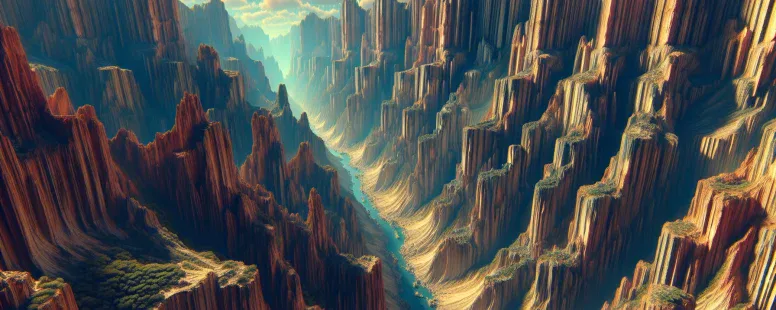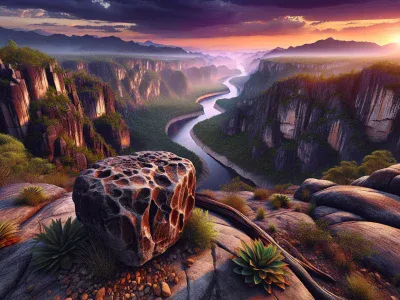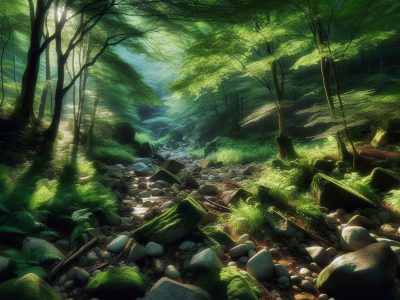Difference Between Weathering and Erosion: Key Processes, Examples, and How They Shape Our World
Picture standing on the edge of a windswept canyon as sunlight dances across jagged cliffs and scattered stones. You feel the grit of ancient rock beneath your fingers and hear the distant rush of water carving its path below. What invisible forces shape these breathtaking landscapes over centuries—slowly sculpting, breaking, and moving the very ground beneath your feet?
You might think it’s all the same process, but there’s a fascinating story behind how rocks crumble and earth shifts. Understanding the difference between weathering and erosion can reveal hidden secrets about our planet’s past and even help you predict how the world around you will change. Discover how these natural forces work together in a delicate dance, transforming solid stone into sand and carrying mountains away grain by grain.
Understanding Weathering and Erosion
You step onto a mountain trail, feel the gritty soil crunch underfoot, and—unseen—weathering and erosion start rewriting the landscape at a pace slower than your heartbeat. Weathering, you see, breaks down rocks right where they sit. Physical weathering shatters granite on a sunbaked slope as ice seeps into cracks and then expands. Chemical weathering transforms limestone into clay using just rainwater and air; even that statue at the park slowly loses it’s features through acid rain. Biological weathering works when a tree root splits a sidewalk, prying apart slabs like a determined hand.
Erosion, on the other hand, carries those bits away. Picture raindrops pounding a dusty road—each splash sends grains drifting, joining streams on their journey downstream. Rivers—think of the raging Colorado carving the Grand Canyon—or winds sweeping across the Sahara move sediments across continents, not just backyard gardens. Glaciers grind mountain valleys into bowls, leaving behind lakes as memories. Gravity tugs loose boulders off cliffs, filling canyons with rubble over centuries.
Which process leaves more scars: a stone turning to sand in place, or the journey that grain takes in a river’s grasp? If all bedrock vanished overnight, would Earth be a blank page or a shredded manuscript? The United States Geological Survey (USGS) reports erosion moves about 60 billion tons of soil a year globally, shaping every patch of coast and field (USGS, 2022).
You can watch weathering and erosion at work in city parks, deserts, and distant peaks—just look closer at crumbling bricks or muddy streams after a storm. Both processes animate every landscape, their story told in every pebble, sandbank, and mountain silhouette, quietly reminding you the ground beneath is never still.
Defining Weathering
Weathering describes the process of breaking rocks apart without moving them. You’ve seen it: a crumbling gravestone in an old cemetery, the rough face of a city statue, or the splinters of cracked brick on your walk to school. If a stone wall seems older and weaker each year, weathering’s probably behind the transformation.
Types of Weathering
Weathering splits in three main types. Physical weathering breaks rocks using force—think frost wedging, where water sneaks into cracks, freezes, then pries the rock open. In Yosemite, granite cliffs show these scar lines, split by countless freeze-thaw cycles. Chemical weathering changes the actual minerals in rocks, like acid rain eating away at marble monuments. Biological weathering follows a different route: roots inched their way into sidewalk crevices, breaking concrete, or lichens producing weak acids as they grow on boulders.
| Type | Example Entity | Action |
|---|---|---|
| Physical Weathering | granite cliff, ice, wind | mechanical fragmentation, pressure release |
| Chemical Weathering | acid rain, limestone, oxidation | mineral transformation, dissolution, rusting |
| Biological Weathering | tree root, lichen, microbes | organic acid generation, root penetration, microbe metabolism |
Processes Involved in Weathering
Physical, chemical, and biological agents carry out weathering processes with varying impact. Wind constantly scours the faces of sand dunes, sculpting their shape grain by grain. Rainwater, slightly acidic, reacts with feldspar in granite, turning it into soft clay. Oak trees’ roots snake deeply below street level, prying up slabs of pavement one season at a time. Sometimes you might wonder why ancient ruins or cliff faces never look quite the same, even just a year apart—weathering’s relentless clock answers that question.
Did you know different minerals resist weathering at unequal rates? Quartz endures much longer than olivine, for instance. It’s the reason some pebbles last centuries in a riverbed, while others crumble and wash away quickly (see Brantley, 2008, Elements Magazine). Weathering’s silent, patient touch changes landscapes far before you even set foot on a trail or gaze out at Monument Valley.
When you trace the veins in a cracked driveway or peer at the color changes in a canyon wall, you’re seeing the hidden artistry of weathering at work. Which examples stood out most in your local neighborhood, and what clues tell you how weathering has shaped their story?
Defining Erosion
Erosion moves earth’s surface materials from one place to another, reshaping familiar landscapes with each gust of wind or splash of water. You’ll spot its results anywhere that dust sweeps across a sidewalk, or after heavy rains expose tree roots in a riverbank.
Types of Erosion
You encounter several types of erosion shaping the world around you.
- Water erosion sculpts valleys and canyons, with rivers carrying soil downstream—think of the Grand Canyon, where the Colorado River carved sheer walls over millions of years (USGS, 2023).
- Wind erosion whips sand across fields and deserts; you might see this in Dust Bowl-era farmlands or the dunes of the Sahara, grains traveling hundreds of miles.
- Glacial erosion drags rocks like sandpaper, gouging U-shaped valleys wherever ice sheets advanced, as in Yosemite National Park.
- Coastal erosion wears away cliffs with every breaking wave—Cape Cod loses several feet of shoreline each year (NOAA, 2022).
- Gravity erosion pulls rocks down slopes; think landslides, rockfalls, and mudflows after big storms.
In each scenarios, the moving force removes loose particles, transporting them far from they origin.
How Erosion Occurs
Erosion happens whenever natural forces—water, wind, ice, gravity—move weathered rock or soil. After a rainstorm strips muddy footprints from a park path, that’s erosion in action. You observe the results every time a sandcastle crumbles at the tide’s edge.
Many factors influence the rate and scale of erosion, including slope steepness, vegetation cover, and human activity. Bare slopes erode faster than forested ones, while strong winds can overwhelm fragile grasslands. Construction, agriculture, and deforestation accelerate the process, often leading to rapid landscape changes.
The journey of sediment tells a story: tiny grains leaving a hillside might someday settle at the bottom of delta marshes, forming new land. Earth’s constantly shifting canvas owes its shape to these relentless, unseen sculptors.
Key Differences Between Weathering and Erosion
You’ll spot the divide between weathering and erosion right on every hiking trail and roadside outcrop. Each process shapes your surroundings, but their roles stay sharply distinct.
Physical and Chemical Changes
Physical changes caused by weathering break rocks into smaller pieces but don’t move them anywhere. Picture frost wedging when winter ice splits apart a chunk of sidewalk, or roots prying open cracks in granite boulders. Chemical changes dissolve or alter the minerals—like acid rain etching marble headstones or iron in rocks rusting to red dust. Erosion skips the slow breakdown and does the heavy lifting, carrying bits away. If you ever picked up soft sand from a windy dune, you’ve held the handiwork of wind-driven erosion; unlike static weathering, erosion act’s as a transporter, not just a breaker.
Movement of Materials
Movement defines erosion. Rivers sweep away what rain and roots have loosened, creeks carve miniature canyons, and glaciers grind valleys deeper by dragging sediments for miles. Your footprints on a muddy trail hint at gravity-induced erosion as soil shifts downhill step by step. Weathering finishes its work at one spot; erosion always changes the address. Think about this the next time you see silt clouding a stream after a storm—weathering made the mud, erosion delivered it downstream where new land might form if enough time pass. These relentless movements link the fate of mountaintops to the mudflats far below, and the stories written in each grain reveal aeons of restless change (National Geographic, USGS).
Real-World Examples and Impacts
Weathering and erosion shape every landscape you see, carving valleys and sculpting coastlines in ways that few notice day by day. Picture a mountain crumbling grain by grain, each tiny fragment’s journey told through the earth beneath your feet.
Effects on Landscapes
Mountains shrink, cliffs recede, and riverbeds twist because weathering and erosion work nonstop across continents. The Grand Canyon, formed over millions of years, offers a dramatic display where water erosion—mainly from the Colorado River—carved through layers of limestone, sandstone, and shale. In contrast, you can spot physical weathering in a cracked stone wall in your neighborhood, where freeze-thaw cycles wedge rock apart bit by bit.
Glaciers, heavy and relentless, have scraped entire valleys into broad, U-shaped troughs such as Yosemite Valley, where gouged granite bears witness to an ancient icy grip. Coastal bluffs in California recede several feet each decade (USGS), where relentless waves and storms eat away at the land, leaving sea stacks as monuments to vanished cliffs. what stories a pebble could tell, tumbling for centuries down a river or across a windswept dune?
Environmental Significance
Soil loss, water quality, and ecosystem balance—weathering and erosion impacts ripple out in unexpected ways. About 12 million hectares of farmland lose productivity each year due to soil erosion (FAO). Rivers clog with sediment, which can smother aquatic habitats and disrupt fish breeding grounds, affecting both wildlife and the water you might drink downstream.
Biological weathering, driven by the humble lichen or a stubborn root, enriches soil by releasing nutrients from rock, supporting forests and crops worldwide. Airborne dust, eroded from Sahara Desert, crosses the Atlantic and feeds the Amazon rainforest (NASA), illustrating global connections hidden in each gust of wind.
Floods grow worse in deforested regions because plants that once anchored soil and slowed water are lost. Erosion doesn’t just rearrange land; it reshapes societies, challenges engineers, and inspires scientists searching for ways to rebuild what’s lost. Would future generations inherit mountains or mud if today’s choices tip the balance? The story, still unfolding, invites you to watch your world with new eyes.
Conclusion
When you start noticing the subtle marks of weathering on an old stone or the shifting shapes of a nearby riverbank you’ll see how these natural forces are always at work. Understanding the difference between weathering and erosion not only deepens your appreciation for the world’s landscapes but also helps you recognize the ongoing changes happening right around you.
By observing these processes in your everyday environment you’ll gain a new perspective on how even the smallest changes can lead to dramatic transformations over time. Let your curiosity guide you as you explore the ever-evolving story of Earth’s surface.
- Who Is Better Messi or Ronaldo? A Deep Dive into Football’s Greatest Rivalry - October 29, 2025
- Pros and Cons of Partnerships: Key Benefits and Challenges to Consider - October 29, 2025
- King vs Queen Size Bed: An In-Depth Comparison for Your Perfect Mattress Choice - October 29, 2025







